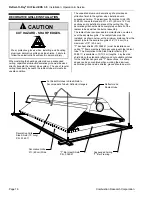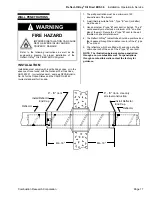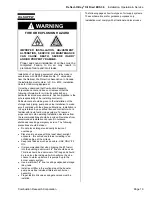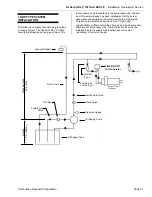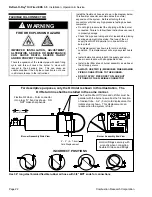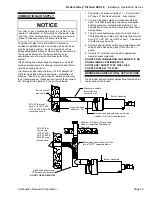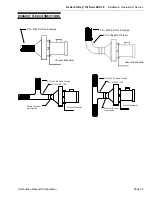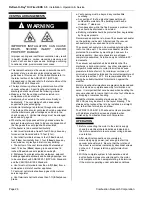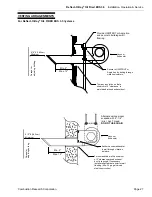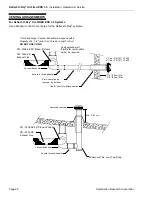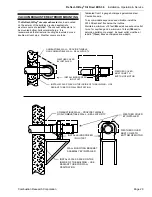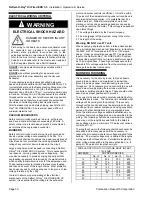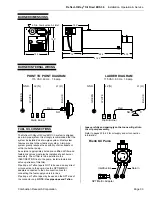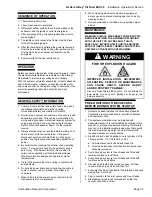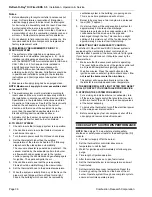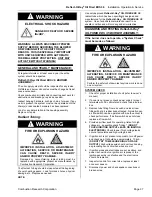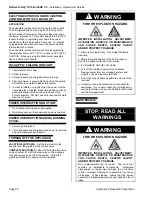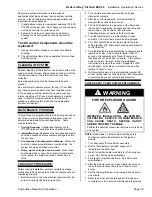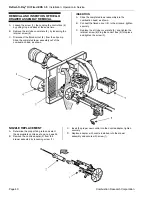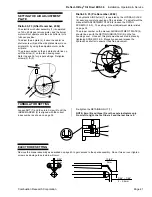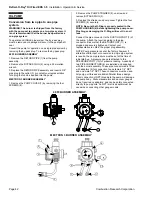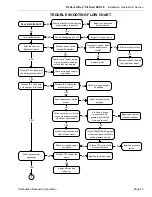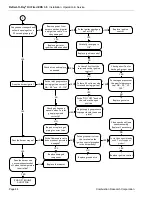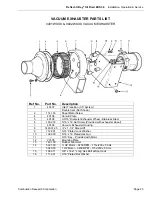
Reflect-O-Ray
®
Oil Fired EDS 3.5
Installation, Operation & Service
Page 30
Combustion Research Corporation
ELECTRICAL WIRING CRITERIA
WARNING
ELECTRICAL SHOCK HAZARD
DANGER OF SEVERE INJURY
OR DEATH
Field wiring to the heater and vacuum exhauster must
be connected and grounded in accordance with
national, state, provincial, local codes and to the
guidelines outlined in this manual. In the United States
refer to the most current revisions to National Electric
Code and in Canada refer to the most current revisions
to the Canadian Electric Code Part I Standard.
DO NOT
use unless electrical wiring complies with all
applicable codes.
DO NOT
wire without providing for a power source
disconnect at the burner assembly and the Vacuum
Exhauster.
The requirements and practices described below are
based on the National Electrical Code ANSI/NFPA No. 70-
(current standard) and the Space Heating Standard or the
Underwriters Laboratories, Inc. (UL), the Canadian
Electrical Code CSA C22.1 Part 1 (current standard) apply
in Canada. Although UL & CSA requirements are uniform
throughout the country, local electrical codes may deviate
from these codes, therefore local inspection authorities
should be consulted regarding local requirements.
After final assembly and before shipping, each
Reflect-O-
Ray
®
OIL FIRED EDS 3.5
burner must pass a 500 volt
minimum dielectric test.
VACUUM EXHAUSTERS
Safety control circuits must be a two-wire, with ground,
and have a nominal voltage not exceeding 125 volts. A
safety control or protection device must be connected so
as to interrupt the ungrounded conductor.
BURNERS
Safety control circuits must be two wire with ground and
have a nominal voltage not exceeding 125 volts. The
control circuit shall be connected to a power supply branch
circuit fused at not more than the value appropriate for the
rating of any control or device included in the circuit.
Large enough wire must be used in connecting a
Reflect-
O-Ray
®
OIL FIRED EDS 3.5
system. This is necessary for
two reasons - carrying capacity, and voltage drop. The
wire size necessary to provide carrying capacity without
overheating is generally determined by the electrical code
which specify a minimum wire size for the amperage used.
These requirements are intended to prevent overheating
and take no account of the length of wire. Most problems
have been caused by voltage drop due to long runs, or low
voltage furnished by the utility.
In order to assure proper operation of the electrical
components of the
Reflect-O-Ray
®
OIL FIRED EDS 3.5
system
, it is essential that the voltage to the exhauster
motor and burner controls is sufficient. It must be within
10 percent of the nameplate rating under all conditions to
assure satisfactory operation. It is preferable that it be
within 5 percent. Almost all complaints of motor not
starting or not reaching operating speed are caused by
low voltage reaching the motor. This voltage is dependent
upon three things:
1. The voltage furnished by the Power Company.
2. The size (gauge) of the electrical wiring to the motor.
3. The length of the wiring.
Warning DO NOT use 277 volt.
When supplying single phase from a three-phase system,
use a suitable sized machine tool transformer to transform
the 460V or 230V three-phase to 230V or 115V single
phase. Under no circumstances use 277V single phase
input to the
Reflect-O-Ray
®
OIL FIRED EDS 3.5
system.
The resulting output from a two-to-one transformer would
be 138V single phase. These high voltages exceed the
allowable 10% voltage variation from the normal and will
damage the electrical components.
BURNER GROUNDING
It is necessary for the circuit ground, (L2) and chassis
ground to be common and maintained to an earthen
ground rod using copper (not aluminum) ground wires
throughout. Do not assume ground continuity to an earth
ground via oil supply piping, burner tubes, electrical
conduits or building structural steel. These should not be
assumed as proper positive earth grounds.
The correct size wire should be carefully selected before
the installation is made. The first step is to establish what
voltage will be coming into the building. This will vary
throughout the country and must be determined locally by
checking with your power company and using experience
gained with other installations in your geographic area.
Once the minimum voltage available is established, you
will know how much voltage drop can be permitted in the
wiring. The following chart shows maximum wire lengths
(one way, not the length back and forth to the t/stat) to
keep voltage drop to a minimum of 10 percent at various
currents at 115V.
The lengths shown in the following chart should never be
exceeded and in many cases it will be necessary to
reduce them to accommodate low voltage supplied to the
building. If 5 percent voltage drop is desired, the lengths
will be one-half of those shown. Permissible lengths for
other voltage drops will be in the same proportion, i.e., 8
percent = 80 percent of length shown, etc.
WIRE LENGTH FOR 10% VOLTAGE DROP IN FEET -
115V 60HZ
AMPERES
COPPER WIRE SIZE
No. 14
No. 12
No. 10
No. 8
15
150
225
350
600
20
110
175
275
450
25
90
140
225
350
30
75
125
150
300
35
-
100
135
250
40
-
85
125
225
45
-
-
110
200
50
-
-
-
175
!
Содержание reflect-o-ray eds 3.5
Страница 4: ......
Страница 57: ...Reflect O Ray Oil Fired EDS 3 5 Installation Operation Service Combustion Research Corporation Page 53 NOTES...
Страница 60: ......
Страница 61: ......

